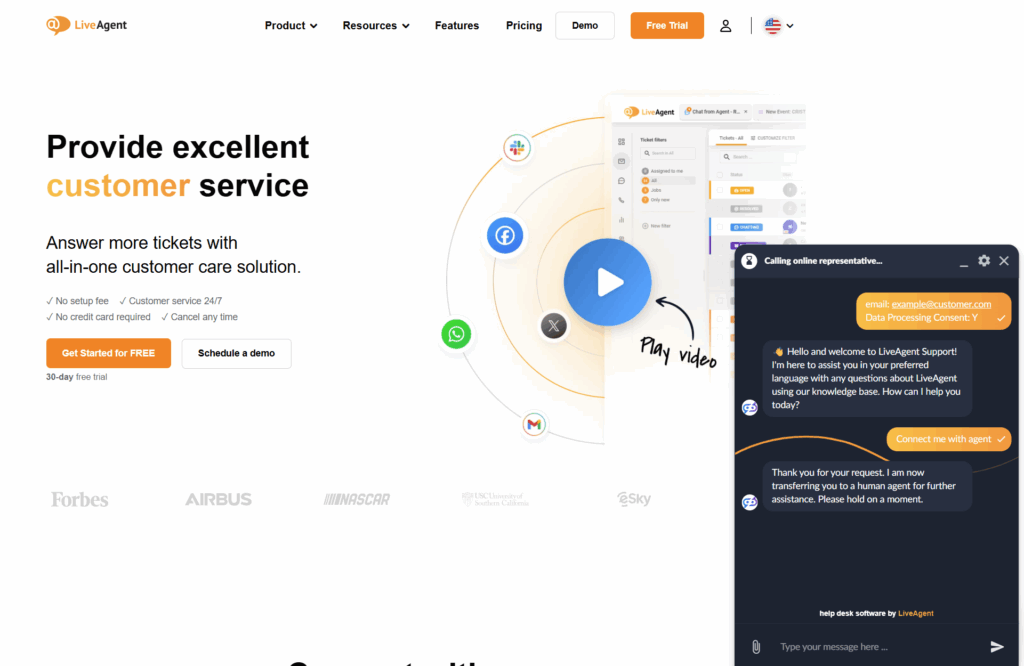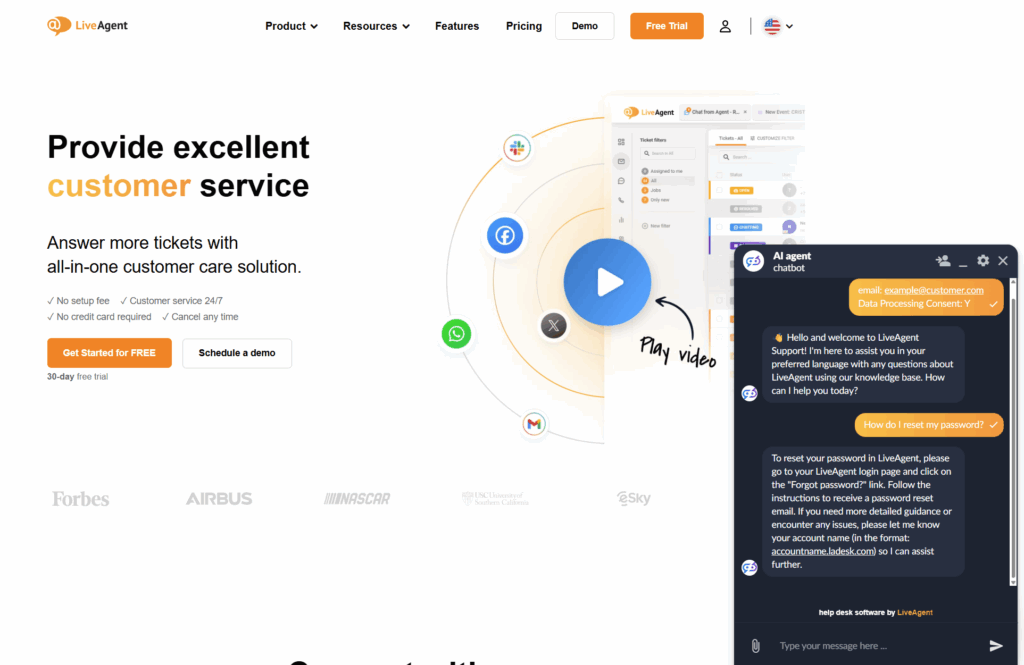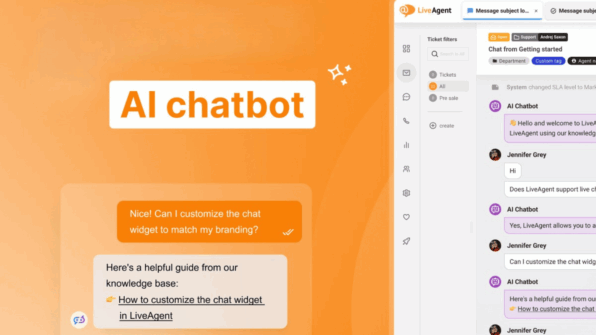LiveAgent operates a large SaaS website that attracts significant visitor traffic. While many visitors are interested in our product, a substantial portion access non-product-related pages, such as blogs or glossary entries. As a result, our customer support team was overwhelmed with a high volume of chat inquiries. However, many of these chats were unrelated to product support, including general questions, misrouted requests, or even off-topic inquiries.
Despite this, our support agents had to handle them, which took their time away from assisting real customers with valid product-related issues. The team was struggling with increased response times, which reduced overall support efficiency.
We needed a solution to filter, sort, and handle customer interactions without losing the ability to provide help where it was truly needed. And this is where the AI chatbot came into play.
Since implementing the AI chatbot, a huge volume of visitor questions has been filtered right at the first point of contact. This has resulted in LiveAgent AI chatbot resolving 75% of all chat interactions across all LiveAgent websites. Let’s see the whole story behind it.
Smarter support for a growing customer base
Developed in 2006 by two pioneering developers in Slovakia, LiveAgent has evolved into a versatile customer support tool, offering live chat, ticketing, and help desk capabilities used worldwide. Today, we serve over 150 million users and over 40,000 businesses worldwide.
With a large website and heavy traffic generating a high volume of customer queries, in 2024 LiveAgent’s customer support team recognized the need to optimize support interactions. “To address this, we implemented an AI chatbot to efficiently manage and filter customer requests, ensuring faster, more focused support that continuously evolves with the needs of LiveAgent’s customers,” says Jozef Štofira, Head of LiveAgent’s Customer support team.
Operational challenges for the support team
When our customer support team decided to deploy AI Chatbot, they wanted to address these main challenges:
1. Lighten agents’ workload
Approximately 3500 live chats with clients were handled by human agents monthly, 1500 of which were misdirected inquiries. This made it difficult for the team to prioritize their time and focus on important, product-related queries.
2. Delegate tasks to human agents intelligently
Around 2300 contact forms on industry-related content pages of LiveAgent were handled only by automation rules to avoid the support team overload (with mainly additional misdirected inquiries). However, relying solely on automated templates, rather than personalized responses, was leading to a noticeable decrease in response quality and, in some cases, missed opportunities or delays in addressing legitimate customer inquiries.
3. Supporting focused work, not chat chaos
With the growing customer base over the years, LiveAgent’s customer support agents were receiving enormous amounts of requests. As a result, agents often had to juggle several parallel chats at once, frequently switching between topics and questions, many of which were not even directly related to the product itself. This constant disruption made it difficult for agents to maintain focus, or pay their full attention to truly product-related inquiries.
4. Scaling support without scaling costs
Before implementing LiveAgent AI Chatbot, handling growing volumes of incoming chats was becoming unsustainable. With monthly interactions rising by 25%, the team faced the challenge of scaling support without significantly increasing costs or overloading their agents. Hiring additional agents would have required an additional investment. They were looking for a cost-effective way to manage simple, repetitive queries while keeping the customer support team focused on more complex issues.

Moment of truth: LiveAgent AI Chatbot deployment
After experimenting and testing various contact options, we fully deployed the LiveAgent AI chatbot on our webpage, following these steps:
- Selected specific parts of the website (blogs and glossaries) for the initial deployment.
- Connected account with an AI provider – FlowHunt, and set up the chatbot using the recommended initial template, customizing it with their specific information and requirements:
- Integrated both the website and our knowledge base as primary knowledge sources for the chatbot.
- Defined escalation rules to ensure seamless handover to human agents when necessary.
- Created new chat widgets utilizing the chatbot.
- After the setup, we replaced previous contact form widgets on selected (blogs and glossaries) pages.
- Configured automation to tag all chats from these widgets with the “Chatbot” tag and set up rules to tag chats transferred from the chatbot to human agents to monitor performance.
- Monitored chatbot conversations daily, optimizing system prompts and updating FAQs to improve response accuracy and chatbot overall behaviour.
- Rolled out the chatbot to the main page, continuing to enhance performance with further prompt improvements and expanding the FAQ knowledge base.
- Continuously monitored performance metrics and chatbot behavior post-launch for optimal support service and customer experience.
“Rolling out the AI chatbot was easier than we anticipated. By breaking down the process into manageable steps and thanks to clear instructions in setup guides, we made the transition seamless for both our team and our customers.” – Jozef Štofira, head of Customer support at LiveAgent.
More time for impactful conversations
After the LiveAgent AI Chatbot implementation on the LiveAgent webpage, our team has seen outstanding results:
- 75% of all chat interactions are now resolved by the chatbot across all LiveAgent web pages, including blogs, directories, and glossary pages.
- A 48.5% drop in live chats requiring human agents: from 3,500 to just 1,800 per month — was achieved thanks to the AI chatbot efficiently handling routine inquiries.
- 40% of chat interactions are now successfully handled by the AI chatbot on LiveAgent Product web pages.
- 25% increase in total chat interactions (from 5,800 to 7,300) without hiring additional support agents, thanks to the chatbot’s ability to manage a high volume of simple queries.
- 5600 chats per month are successfully addressed by the chatbot, with an additional 800 chats handed over to human agents for further assistance.
“Support agents can now focus on fewer, more complex chats at a time, typically handling just one or two simultaneously, rather than being distracted by multiple parallel chats of varying complexity” – Jozef Štofira, head of Customer Support at LiveAgent.

What’s next? Expanding AI Chatbot coverage
LiveAgent’s journey with chatbot implementation has already delivered significant improvements in efficiency, but they see this as just the beginning. Looking to the future, we have plans to further leverage AI use in our customer support.
One of our key initiatives is to create knowledge base articles with AI from resolved tickets. By transforming agents’ resolved support interactions into valuable, easily accessible knowledge FAQ, LiveAgent aims to empower our AI chatbot to answer an even broader range of questions with higher accuracy.
We are also excited about the upcoming release of an enhanced version of the AI answer assistant in the platform. This will enable our customer service team to utilize AI more effectively, not only for chat interactions but also for managing email-based tickets. With this capability, we anticipate faster resolutions and even more consistent support quality across all channels.
AI and human support in perfect sync
Get started with LiveAgent AI Chatbot, which integrates over 15 advanced AI models to enhance your customer experience.
Share this article
The right help desk for every business
LiveAgent is a help desk software that adapts to the needs of different business models. Explore how LiveAgent fits your niche. Agency Edu and NGOs rely on LiveAgent.
How IdoSell achieved 100% customer satisfaction and scaled global support with LiveAgent
Idosell boosts efficiency with LiveAgent! 14 agents deliver 100% satisfaction to 4,000+ clients via email, chat, and calls. Try LiveAgent now!"
How CS Apparel Group launches new support lines in minutes with LiveAgent
CS Apparel Group improved support speed by 75% with LiveAgent—launch new lines in minutes and boost customer satisfaction. Try free!
How CS Apparel Group launches new support lines in minutes with LiveAgent
CS Apparel Group boosts customer support with LiveAgent: +75% faster email replies, +17% SLA calls, easy multi-channel setup in minutes!

 Български
Български  Čeština
Čeština  Dansk
Dansk  Deutsch
Deutsch  Eesti
Eesti  Español
Español  Français
Français  Ελληνικα
Ελληνικα  Hrvatski
Hrvatski  Italiano
Italiano  Latviešu
Latviešu  Lietuviškai
Lietuviškai  Magyar
Magyar  Nederlands
Nederlands  Norsk bokmål
Norsk bokmål  Polski
Polski  Română
Română  Русский
Русский  Slovenčina
Slovenčina  Slovenščina
Slovenščina  简体中文
简体中文  Tagalog
Tagalog  Tiếng Việt
Tiếng Việt  العربية
العربية  Português
Português 




